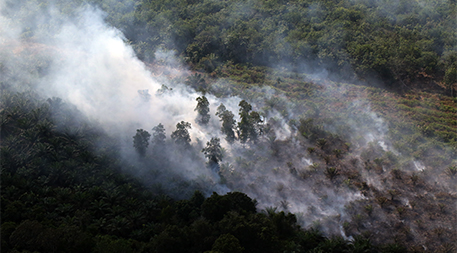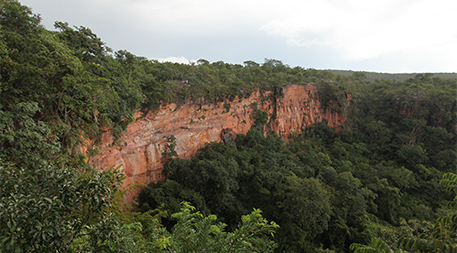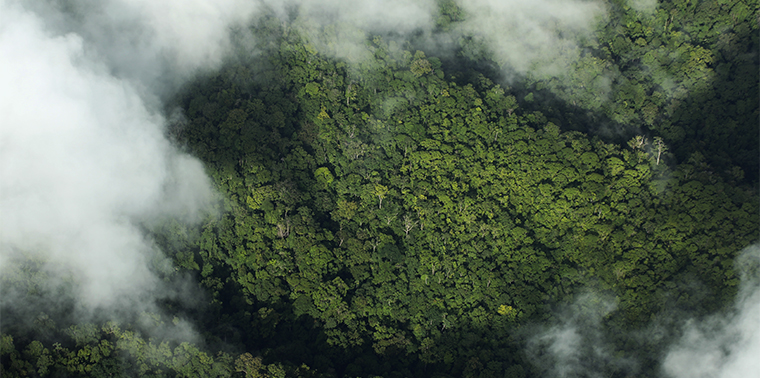January 21, 2016 — It started, as many things do, with a rumor. In 2013 Matt Finer, a researcher with the Amazon Conservation Association, heard from locals that someone was cutting down rainforest deep in the Peruvian Amazon, far from prying eyes. So Finer and colleagues did something that would have been unheard of 10 years before: Using high resolution satellite imagery, they found a couple hectares of felled trees in a seemingly impenetrable sea of forest.
“You could just see this little smidge of forest loss and we said, ‘maybe that’s it,’” says Finer.
Over the next few years, the team watched the destruction spread from just a few hectares to more than 2,000. It eventually connected the loss to United Cacao, a company based in the Cayman Islands with ambitions to become the “world’s largest and lowest cost corporate grower of cacao,” according to its website. Armed with dramatic satellite images, Finer and colleagues took the story to the Peruvian government and press, hoping to make a difference. The case is now in Peruvian court to determine if the company undertook the proper steps before clearing the forest. In the meantime, according to Finer, the agriculture ministry has responded by slapping United Cacao with a “paralyzation” order to halt its operation. But, says Finer, weekly satellite imagery shows United Cacao is not complying. “The deforestation is happening as we speak,” he says.
The world has struggled for decades to stem deforestation through a variety of means. In 2008, biodiversity expert Norman Myers said that deforestation in the tropics was “one of the worst crises since we came out of our caves 10,000 years ago.” Ongoing loss is driving fears of mass extinction. But the loss of forests — both tropical and temperate — also plays a big role in the global climate crisis: Experts estimate that 10 to 15 percent of current greenhouse gas emissions are due to land use change. Not only that, but forests are vital to mitigating soil erosion, stemming floods, maintaining precipitation and even boosting human health and happiness.
The world has struggled for decades to stem deforestation through a variety of means, including setting aside new protected areas, improving laws and enforcement at the national level, creating international programs such as REDD+, and making corporate commitments to cut out deforestation altogether.
Yet nothing has changed how we approach deforestation like satellite monitoring. In recent years, this has revolutionized our ability to track deforestation. Instead of relying on local government statistics, researchers and activists are now able to monitor changes in the forest from their laptops and smartphones.
What does this information tell us about how we’re doing at beating deforestation — and what we might do to make further progress toward this global goal?
Global Assessments
Last year, the Food and Agriculture Organization of the United Nations released its latest Global Forest Resources Assessment. According to the assessment, we have seen a net loss of forests of 129 million hectares since 1990, an area about the size of Peru. But the report, released every five years, also found that the rate of deforestation had slowed recently: forests experienced 56 percent less net loss annually in the past five years than during the 1990s. The Global Forest Resources Assessment found a significant slowdown in deforestation in the tropics, while net forest cover in temperate regions was either stable or rising.
Anssi Pekkarinen, leader of the FAO’s Forest Monitoring and Assessment Team, says the team is “quite confident” that deforestation has slowed in the tropics. Between 1990 and 2000, tropical forests lost more than 9 million hectares (20 million acres) annually, but over the past five years annual losses slightly exceed 6 million hectares (10 million acres), according to the Global Forest Resources Assessment. Critics, however, contend the FAO data are marred by dependence on local governments with varying abilities — and desires — to accurately monitor or report forest cover. Moreover, definitions of forest vary depending on the government and the time period, making comparing forest loss over decades difficult.
Meanwhile, one of the most rigorous studies in recent years found that forest loss actually accelerated by 62 percent in the tropics from 1990 to 2010.
Lead author Do-Hyung Kim, a Ph.D. student at the University of Maryland, College Park, says the study, published in 2015 in the journal Geophysical Research Letters, was meant to provide an “alternative” to FAO data based on “a consistent definition and methods.” To do the analysis, Kim and colleagues analyzed 5,444 Landsat satellite images, comparing past and present forest cover using the same definitions.
“Brazil is the exception, not the rule at all, in reducing its rate of deforestation.” – Matt HansenKim’s conclusions are buttressed by findings from a 2013 study in Science that found forest loss in the tropics jumped by more than 200,000 hectares every year from 2000 to 2012. The research declared that Brazil’s recent crackdown on deforestation was negated by rising destruction in other tropical countries, such as Indonesia and Malaysia.
“Brazil is the exception, not the rule at all, in reducing its rate of deforestation,” says lead author Matt Hansen, a remote sensing scientist at the University of Maryland.
There is little disagreement, however, that deforestation has slowed in temperate regions. For one thing, the data are generally more reliable in these regions. According to the Global Forest Resources Assessment, net forest cover has actually risen in countries such as the U.S., Russia and China over the past 15 years. This doesn’t mean these nations aren’t continuing to clear-cut forests, but the total amount of land devoted to forests has grown. China, for example, has undertaken ambitious forest planting programs to combat desertification and soil erosion (although most of these are monoculture plantations rather than diverse forests).
Apples and Oranges
Worldwide, Global Forest Watch — an interactive mapping tool online — has found that tree cover loss has steadily increased (with some fluctuations) between 2001 and 2014. But Rachael Petersen, a research analyst for World Resources Institute, which operates GFW, says comparing the FAO and GFW data is like “comparing apples to oranges.” This is because FAO largely measures land use change, while GFW covers tree cover loss. For example, clear-cutting a forest in the southern United States is not considered deforestation by FAO so long as the land remains designated as a production forest — that is, clear-cut and regrown at regular intervals. But GFW will detect loss for that year, because the satellites see felled trees — even if forests will soon grow there again.
FAO says it does not include oil palm plantations or fruit tree monocultures under its definition of forests, but it does include pulp and paper plantations as well as replanting efforts that usually depend on a single species.“Taken together, [the GFW and Global Forest Resources Assessment] data give us a more complete understanding of how forest landscapes are changing,” says Petersen.
Another major issue plaguing the data today is whether monoculture plantations should be counted as forests. FAO says it does not include oil palm plantations or fruit tree monocultures under its definition of forests, but it does include pulp and paper plantations as well as replanting efforts that usually depend on a single species. And most analyses of satellite data sets don’t distinguish between forest plantations and diverse forests, meaning that research dependent on satellites usually counts mature oil palm, rubber, acacia or other plantations as forest simply because from the a bird’s eye view they look like forest.
But the idea that any monoculture plantation is a forest drives ecologists crazy.
“They’re about as biologically similar to native forests as my front lawn,” says William Laurance, an expert on tropical forests with James Cook University in Australia.
Indonesia vs. Brazil
In the end, no measurement of deforestation is without fault. But, ultimately, we may be missing the point by focusing on relative rates of global deforestation. Even if we go with the best-case slowdown scenario, deforestation is still happening at an unsustainable pace. Every year, our planet has less forest than it did before — and much less primary forest. Every year, more species — many of them not even named — become threatened with extinction or go extinct. And every year more planet-warming carbon enters the atmosphere from destroyed forests.

Smoke rises from an oil palm plantation and forest in Riau province, Indonesia, in 2015. Photo © Rhett A. Butler/Mongabay
This is nowhere more evident than in Indonesia, which in 2015 saw 2.1 million hectares (5.2 million acres) of land — much of it peat and rain forest — go up in smoke.
During the dry season, farmers and plantations routinely clear peat and rainforest in Indonesia by burning it, creating a toxic haze that blankets the wider region. But last year — due in part to El Niño and global warming — the fires proved particularly fierce and long lasting. Erik Meijaard, an Indonesia-based ecologist, dubbed them “the biggest environmental crime of the 21st century” even as the months-long crisis failed to capture anywhere near the global media attention as the Deepwater Horizon oil spill in the Gulf of Mexico in 2010.
In all, the disaster resulted in the direct deaths of 21 people, at least half a million acute respiratory infections, hundreds of cancelled flights and immeasurable impacts to wildlife. The World Bank estimated a total loss to the Indonesian economy estimated at more than US$16 billion. It also released a carbon bomb: At the height, the fires emitted more carbon dioxide on a daily basis than the entire U.S. economy.
For those who have followed the turmoil of Indonesia’s forest policies, none of this was surprising. Suffering from decades of corruption, lax laws, decentralized governance and powerful industrial players, Indonesia’s forests are in crisis.

In Brazil, protected areas such as Chapada Diamantina National Park help shelter forests from destruction. Photo © Rhett A. Butler/Mongabay
But, maybe Indonesia should look to Brazil. The Amazonian country was once the global pariah when it came to rain forest destruction. Now experts repeatedly point to it as a model for how to really take on deforestation. A leader in the application of satellite monitoring, Brazil has combined the new technology with strong governance, tough forest laws and vast protected areas. And it’s working: Deforestation in Brazil slowed 70 to 80 percent from the early 2000s to today — though it has risen slightly in recent years.
“Brazil is the best to date in intervening in an ongoing deforestation dynamic and actually greatly reducing it,” says Hansen, who points to the country’s “vigorous civil society, government mandates and an engaged private sector” as key to the initial success. In a nutshell, Brazil’s many stakeholders came together to take on a hugely complex, but not unsolvable, problem. The battle is not over there, but it is moving in the right direction.
“Replicating those conditions elsewhere may prove challenging,” Hansen says. For instance, in Indonesia, the palm oil industry routinely plays down the problem and the government still sends mixed messages on the importance (or lack thereof) of protecting forests, even going so far as to criticize recent zero deforestation pledges by corporations.
Moving Forward
Many hold out hope that the Paris climate agreement, signed by virtually every nation in the world in December, could point to a new era for the world’s forests. Included in the agreement is a request that countries conserve and enhance forests in order to mitigate carbon emissions.
Every year more of the world’s biggest corporations and industries are announcing “zero deforestation” pledges.The Paris agreement also lent considerable support to REDD+, a long-debated program that establishes a mechanism by which wealthy nations pay poor tropical countries to keep their forests standing. Under discussion for a decade, the program has yet to prove itself and still faces a number of critics. But a commitment of $5 billion by Norway, Germany and the UK to REDD+ announced on day one of the Paris talks should see the program finally kick into high gear.
At the same time, every year more of the world’s biggest corporations and industries are announcing “zero deforestation” pledges, a trend started in Brazil in 2008. Many of these pledges don’t go into effect for 5 or even 15 years and, even more problematic, such pledges often only apply to so-called high conservation forests, a definition that remains under heavy debate but basically means forests with high carbon content or rare species. Still, such pledges show that at least some in the private sector are beginning to view deforestation as no longer permissible.
Finally, experts say that recognizing the rights of local people and indigenous groups to their traditional forests could be one of the easiest, cheapest and most effective ways to protect standing forests from razing. Many indigenous groups still lack legal tenure to their traditional lands in tropical countries, but where they have secured their rights — for example in parts of Brazil — research often shows that forests are well protected. In some cases indigenous groups were even better at halting deforestation than government sanctioned protected areas. Efforts to achieve indigenous rights to forests are ongoing, but sluggish for many of those groups who are watching their forests — and their way of life — vanish to chainsaws.
Concerned citizens elsewhere are also doing their part by being conscientious about purchases that may come with deforestation baggage, including everything from paper to timber and beef to palm oil. Just as important is to support courageous groups and individuals putting pressure on world leaders to protect our remaining forests amid the twin climate and biodiversity crises. If Brazil is any example, we’ll need all hands on deck — governments, industry and citizens — to truly end deforestation. ![]()
Ensia shares solutions-focused stories free of charge through our online magazine and partner media. That means audiences around the world have ready access to stories that can — and do — help them shape a better future. If you value our work, please show your support today.
Yes, I'll support Ensia!
